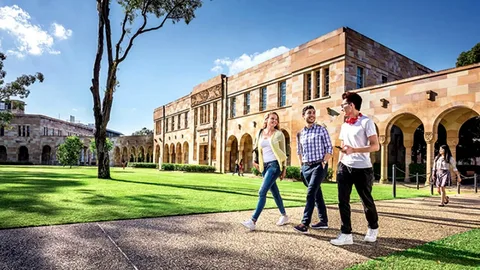Jobs and education
From Talk to Action: Tips for Enhancing DEI Messaging and Propelling Change in the Workplace

Diversity, equity, and inclusion (DEI) have become prominent topics in today’s workplaces. Companies are recognizing the importance of creating a diverse and inclusive environment that values all employees regardless of their race, gender, sexuality, or any other characteristic. However, talk is not enough to create real change. It takes action to make a difference. In this blog post, we will provide tips for enhancing your DEI messaging and inspiring change within your workplace. Whether you’re an HR manager or an employee who wants to create positive change in your organization, these tips will help you propel forward towards meaningful progress. Let’s dive in!
DEI Messages: What They Are and Why They Matter
DEI messages refer to the communication and messaging that promote diversity, equity, and inclusion within an organization. These messages are essential because they help shape the culture of the workplace by setting expectations for behavior and attitudes towards others. DEI messages can come in many forms, including posters, emails, meetings, or training sessions.
The importance of DEI messaging cannot be overstated. When employees see clear and consistent messaging from their leaders about valuing diversity and creating an inclusive environment, it validates their experiences as individuals with unique identities. It also sets a standard for how everyone should behave towards each other in the workplace.
DEI messaging also helps hold leaders accountable for creating a diverse and inclusive environment by ensuring that everyone is on the same page about what is expected of them. It demonstrates to employees that their leadership team values DEI enough to prioritize its promotion through regular communication channels.
In summary, crafting strong DEI messages is important because it communicates your organization’s values around diversity, equity and inclusion while also holding all members accountable for promoting these values in daily actions at work.
DEI Change Agents: How They Work and How to Inspire Them
DEI change agents are the individuals who drive DEI initiatives forward in an organization. They play a crucial role in promoting diversity, equity, and inclusion within their communities by advocating for change and fostering a culture of inclusivity.
To inspire these change agents, it’s important to provide them with the resources they need to succeed. This can include providing access to training programs on DEI topics, creating safe spaces for open discussions about diversity issues in the workplace, and recognizing their contributions through rewards or promotions.
It’s also essential to foster a sense of community among your change agents. Encourage them to collaborate with one another on projects and provide opportunities for networking events where they can share ideas and best practices.
Above all else, it’s important to lead by example as an organization. If leadership demonstrates a commitment to DEI values, then employees will be more likely to follow suit. By empowering your DEI change agents and supporting their efforts towards positive transformation in the workplace, you can create a culture that embraces diversity, equity, and inclusion at every level of your organization.
Communication Tools for DEI Leaders
Communication is key when it comes to promoting diversity, equity and inclusion (DEI) in the workplace. DEI leaders must be equipped with effective communication tools to propel change within their organization.
One important tool for DEI leaders is active listening. This involves giving undivided attention to others and seeking to understand their perspectives. Leaders can also engage in open dialogue through town hall meetings or focus groups where employees can express their thoughts and concerns about DEI issues.
Another useful tool is storytelling. Sharing personal stories of how diversity has impacted one’s life helps create connections and empathy among team members. It allows individuals to see the importance of DEI beyond just a checkbox exercise.
Data analysis is another important tool that leaders should use in communicating the impact of DEI initiatives on organizational success. By measuring progress, highlighting areas of improvement, and sharing successes, leaders can effectively communicate the value of prioritizing DEI efforts in the workplace.
Social media platforms such as LinkedIn or Twitter are excellent tools for spreading awareness about your organization’s commitment towards diversity initiatives. Social media lets you share your success stories with a larger audience while keeping everyone up-to-date on any new developments taking place internally.
Incorporating effective communication tools into DEI leadership strategies enhances employee engagement and promotes an inclusive work environment where everyone feels valued for who they are regardless of race, gender identity or background.
Conclusion
Enhancing DEI messaging and propelling change in the workplace requires an ongoing effort. It’s not a one-time project or initiative but rather a continuous process that involves everyone in the organization.
Effective DEI messaging should be authentic, transparent, and inclusive of all voices. Leaders who prioritize diversity, equity, and inclusion must lead by example with clear communication and accountability for their actions.
Additionally, creating a culture that is welcoming to diverse perspectives requires active listening and open-mindedness from all members of the team. This means challenging biases at every opportunity while also recognizing unconscious bias as an inherent part of human nature.
By following these tips for enhancing DEI messaging and propelling change in the workplace, organizations can create environments where all employees feel valued and supported on their journey towards success.
Development
A Comprehensive Guide to Studying in Australia with IVY Overseas
Development
IVY Overseas: Premier Education Consultants in Hyderabad
Beauty Fitness
Ultimate Guide to Buying Quality Beet Juice for Optimal Health

Are you wondering where to buy beet juice that’s both high-quality and effective? You’re not alone. As more people discover the incredible health advantages of this ruby-red superfood, the demand for premium beetroot products continues to surge.
However, navigating the crowded marketplace can feel overwhelming. This detailed guide will walk you through everything you need to know about purchasing the best beet juice for your wellness journey.

Understanding the Beet Juice Phenomenon
Before exploring purchase options, it’s essential to grasp why beet juice has become a staple in health-conscious households worldwide. This nutrient-dense beverage contains an impressive array of vitamins, minerals, and potent antioxidants that support overall wellness. The real game-changer, however, is its exceptional concentration of dietary nitrates.
Your body transforms these nitrates into nitric oxide, a molecule that influences numerous physiological processes. From enhancing blood circulation to optimizing oxygen transport throughout your system, nitric oxide serves critical functions. Many individuals exploring natural wellness solutions have discovered the important relationship between nitric oxide and erection health, as enhanced circulation provides benefits that extend far beyond exercise performance.
Your Best Options for Purchasing Beet Juice
1. Dedicated Online Health Retailers (Top Choice)
Purchasing from specialized online platforms represents the most practical approach to securing premium beetroot juice. These digital marketplaces focus exclusively on wellness products and typically provide:
- Reliable standards: Established online retailers enforce rigorous quality protocols
- Extensive selection: Various formats from concentrate shots to full-size bottles
- Comprehensive details: Full nutritional profiles and usage guidelines
- Authentic feedback: Genuine testimonials from verified purchasers
- Hassle-free shipping: Products arrive at your home
- Competitive costs: Generally more affordable than brick-and-mortar locations
When browsing online, seek out companies that openly share information about their ingredient sourcing, production techniques, and nitrate concentrations. Top-tier brands frequently use organically-grown beets and utilize cold-extraction methods to maintain nutritional integrity.
2. Natural Food Retailers
Specialty health stores and organic markets commonly carry beetroot juice options. Benefits include:
- Physical product inspection before purchase
- Same-day availability
- Contributing to community businesses
- Access to informed employees who can provide guidance
The downside is that inventory might be restricted, and costs often exceed online alternatives.
3. Conventional Supermarkets
Mainstream grocery stores increasingly feature beet juice in their wellness or beverage aisles. While accessible, these options may:
- Include unnecessary sweeteners or additives
- Be watered down with filler juices
- Offer reduced nitrate levels
- Lack the specialization of dedicated brands
4. Fresh Market Vendors and Juice Establishments
Local farmers markets and pressed juice cafes offer freshly-made alternatives. Consider that:
- Quality fluctuates considerably
- Uniformity cannot be guaranteed
- Products expire more quickly
- Premium pricing is standard
Essential Factors When Selecting Beet Juice
Quality Markers
Certified Organic: Guarantees beets are cultivated without chemical pesticides or artificial fertilizers, particularly important since root vegetables can concentrate soil impurities.
Nitrate Concentration: Premium beet juice products should transparently display nitrate levels. Target products offering a minimum of 400mg nitrates per portion for meaningful results.
Component Listing: Simplicity is key. Authentic beet juice should contain very few ingredients—ideally just organic beets and possibly lemon juice for freshness.
Extraction Technique: Cold-extraction or fresh-pressed approaches retain superior nutrients versus heat-based processing.
Zero Added Sweeteners: Natural beet sweetness is sufficient, and supplemental sugars diminish health advantages.
Available Formats
Concentrated Portions: Perfect for athletes and individuals wanting maximum nitrate delivery in compact servings. Typically 70-100ml doses.
Standard Bottles: Practical for everyday use, usually available in 250-500ml sizes.
Dehydrated Powder: Extended storage capability and travel-friendly, though absorption may be marginally lower than liquid forms.
Combination Beverages: Merged with additional vegetables or fruits, which can enhance flavor but potentially reduce beet concentration.
The Research Supporting Beet Juice Advantages
Recognizing the benefits clarifies why quality selection matters. Beet juice ranks among the most concentrated dietary sources in foods high in nitric oxide precursors. When consuming dietary nitrates from beets, your system converts them through a biological pathway involving oral bacteria and gastric processes.
Primary Health Advantages
Heart Health Enhancement: Nitric oxide assists in relaxing and widening blood vessels, supporting optimal blood pressure and circulation patterns.
Exercise Optimization: Research demonstrates beet juice can boost stamina, decrease oxygen requirements during activity, and elevate athletic output.
Brain Function Support: Enhanced blood delivery to the brain potentially supports mental sharpness and cognitive capabilities.
Sustained Vitality: Unlike stimulant-based energy drinks, beet juice delivers lasting energy through optimized oxygen distribution.
Cleansing Properties: Betalain compounds in beets assist liver operations and natural purification mechanisms.
Recommended Beet Juice Quantities
Appropriate amounts vary based on objectives:
- Everyday wellness: 250ml (roughly 8 oz) per day
- Athletic enhancement: 500ml, consumed 2-3 hours pre-workout
- Cardiovascular maintenance: 250-500ml daily with consistency
Begin with modest quantities if you’re new to beet consumption, as some individuals experience digestive adaptation or temporary color changes in bodily waste (completely normal and harmless).
Optimal Timing for Beet Juice Consumption
Athletic Goals: 2-3 hours prior to training permits ideal nitrate transformation and uptake.
General Wellness: Morning intake on an empty stomach or between meals enhances absorption efficiency.
Blood Pressure Management: Consistent daily scheduling helps sustain steady benefits.
Investment Considerations
While cost shouldn’t dictate your decision entirely, understanding value is important:
- High-grade concentrated shots: $3-5 each serving
- Standard bottles: $2-4 per serving
- Volume purchases: Frequently 20-30% reduced pricing
- Recurring delivery: Extra 10-15% price reductions
Premium beet juice constitutes a wellness investment. When evaluating prices, assess the nitrate content per dollar rather than simply volume measurements.
Preservation and Longevity
Sealed Products: Most commercial varieties remain fresh for 12-18 months when kept in cool, dark environments.
After Opening: Refrigerate and finish within 7-10 days for peak freshness and nutrient preservation.
Freshly Pressed: Consume within 2-3 days for optimal quality.
Finalizing Your Purchase Strategy
When determining where to buy beet juice, evaluate:
- Accessibility: How vital is home delivery compared to instant availability?
- Quality standards: Do you need organic validation or particular nitrate thresholds?
- Financial parameters: What’s your comfortable price range for ongoing use?
- Purpose: Are you using it for athletic training, everyday health, or targeted wellness objectives?
- Flavor preferences: Do you want pure beet or mixed varieties?
Warning Signs to Watch For
Overloaded Formulas: Extended ingredient panels featuring preservatives, synthetic flavoring, or sweetening agents.
Unclear Origins: Missing details about beet cultivation location or juice production methods.
Hidden Nitrate Data: Reputable companies should openly communicate nitrate measurements.
Exaggerated Marketing: Watch for inflated health declarations lacking scientific support.
Suspiciously Cheap Pricing: When costs seem unrealistically low, quality is often sacrificed.
Final Recommendation: Your Best Purchasing Approach
For the majority of consumers, buying from a specialized digital retailer delivers the optimal balance of quality, convenience, and affordability. You’ll discover products engineered specifically for maximum wellness impact, featuring transparent details about ingredient origins and nutritional composition.
Prioritize companies that:
- Source organic, non-GMO beets
- Display clear nitrate concentration data
- Use cold-extraction or gentle processing techniques
- Supply customer assistance and educational materials
- Maintain favorable customer testimonials and ratings
- Present flexible buying arrangements including auto-delivery
Final Thoughts
Discovering where to buy beet juice becomes straightforward when you emphasize quality, recognize key purchasing criteria, and select trustworthy suppliers.
You can confidently add this remarkable superfood to your wellness routine. Whether you’re an athlete pursuing performance improvements, someone focused on heart health, or simply aiming to enhance overall vitality, quality beet juice offers valuable nutritional support.
Keep in mind that regularity trumps perfection. Begin with a credible source, observe your body’s response, and modify your consumption accordingly. The advantages of beet juice manifest most effectively through consistent, ongoing use of superior products.
Prepared to embrace the benefits of exceptional beet juice? Choose intelligently, and your body will reward you with improved health and vitality.
-
Business2 years ago
Cybersecurity Consulting Company SequelNet Provides Critical IT Support Services to Medical Billing Firm, Medical Optimum
-
Business2 years ago
Team Communication Software Transforms Operations at Finance Innovate
-
Business3 years ago
Project Management Tool Transforms Long Island Business
-
Business2 years ago
How Alleviate Poverty Utilized IPPBX’s All-in-One Solution to Transform Lives in New York City
-
health3 years ago
Breast Cancer: The Imperative Role of Mammograms in Screening and Early Detection
-
Sports3 years ago
Unstoppable Collaboration: D.C.’s Citi Open and Silicon Valley Classic Unite to Propel Women’s Tennis to New Heights
-
Art /Entertainment3 years ago
Embracing Renewal: Sizdabedar Celebrations Unite Iranians in New York’s Eisenhower Park
-
Finance3 years ago
The Benefits of Starting a Side Hustle for Financial Freedom


































